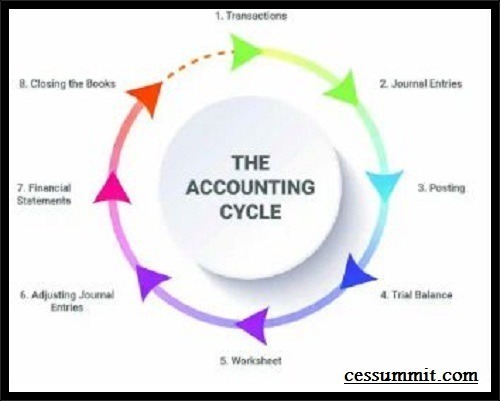
Accounting Circle & How Young Entrepreneurs see it
Accounting Circle & How Young Entrepreneurs see it – As a young entrepreneur, accounting is vital in running your business. However, the importance of accounting in entrepreneurship should not be taken lightly because the revenue earned, the money owed, and expenses incurred are entered into the company’s journal regardless of when the money exchanged hands. This article will show the accounting entrepreneurship ideas that keep a company’s finances afloat. So, read more about Accounting Circle & How Young Entrepreneurs see it
Furthermore, accounting and entrepreneurship work hand-in-hand for the success of any organization as it allows the current and future cash inflows or outflows to combine to give a more accurate model of a company’s current and long-term finances. Also, this post is for business owners, bookkeepers, and accountants who want to process their organization’s bookkeeping tasks accurately.
Contents
- 1 Cessummit.com business tip:
- 1.1 Accounting Circle & How Young Entrepreneurs see it
- 1.2 What is the accounting cycle?
- 1.3 Accounting Circle & How Young Entrepreneurs see it
- 1.4 Understanding the 8-Step Accounting Cycle
- 1.5 Accounting Circle & How Young Entrepreneurs see it
- 1.6 The 8 Steps of the Accounting Cycle
- 1.7 Accounting Circle & How Young Entrepreneurs see it
- 1.8 Accounting Circle & How Young Entrepreneurs see it
- 1.9 Accounting Circle & How Young Entrepreneurs see it
- 1.10 What Is the Difference Between the Accounting Cycle and the Budget Cycle?
- 1.11 What Are the Steps of the Accounting Cycle in Order?
- 1.12 What Is the Main Purpose of the Accounting Cycle?
- 1.13 What Are Some of the Advantages and Disadvantages of Accounting?
- 1.14 Accounting Circle & How Young Entrepreneurs see it
- 1.15 Read Also:
- 1.16 Conclusion:
- 1.17 Share this:
- 1.18 Like this:
Cessummit.com business tip:
At cessummit.com, we take care of the recent entrepreneurship challenges and offer a business plan and financial strategy. Do you have challenges with CAC registration and getting loans and grants for your business? We are a call away. Bookmark this page for future reference!
Accounting Circle & How Young Entrepreneurs see it
To adapt their business models and accounting practices, companies also alter the steps of the accounting cycle. The type of accounting method a business employs determines one of the main changes. Businesses can select between single-entry and double-entry accounting, as well as cash accounting, accrual accounting, and other options. The companies that produce the balance sheet, cash flow statement, and income statement, double-entry accounting is the best option.
What is the accounting cycle?
The accounting cycle is a comprehensive process designed to make a company’s financial responsibilities easier for its owner, accountant or bookkeeper. The accounting cycle breaks down a bookkeeper’s responsibilities into eight essential steps to identify, analyze and record financial information. It serves as a clear guideline for accurately completing bookkeeping tasks. So, read more about Accounting Circle & How Young Entrepreneurs see it
However, the accounting cycle is a holistic process that records a business’s transactions from start to finish, helping businesses stay organized and efficient. The cycle incorporates all the company’s accounts, including T-accounts, credits, debits, journal entries, financial statements, and book closing.
One of the accounting cycle’s main objectives is to ensure all the finances during the accounting period are accurately recorded and reflected in the statements. It’s like a checklist to complete when an accounting period ends.
A business can conduct the accounting cycle monthly, quarterly or annually, based on how often the company needs financial reports.
Accounting Circle & How Young Entrepreneurs see it
Understanding the 8-Step Accounting Cycle
The eight-step accounting cycle starts with recording every company transaction individually and ends with a comprehensive report of the company’s activities for the designated cycle timeframe. Many companies use accounting software to automate the accounting cycle. This allows accountants to program cycle dates and receive automated reports.
Depending on each company’s system, more or less technical automation may be utilized. Typically, bookkeeping will involve some technical support, but a bookkeeper may be required to intervene in the accounting cycle at various points. So, read more about Accounting Circle & How Young Entrepreneurs see it
Every individual company will usually need to modify the eight-step accounting cycle in certain ways in order to fit with their company’s business model and accounting procedures. Modifications for accrual accounting versus cash accounting are usually one major concern.
Companies may also choose between single-entry accounting versus double-entry accounting. Double-entry accounting is required for companies to build out all three major financial statements: the income statement, balance sheet, and cash flow statement.
Accounting Circle & How Young Entrepreneurs see it
The 8 Steps of the Accounting Cycle
The eight steps of the accounting cycle include the following:
Step 1: Identify Transactions
The first step in the accounting cycle is identifying transactions. Companies will have many transactions throughout the accounting cycle. Each one needs to be properly recorded on the company’s books.
Recordkeeping is essential for recording all types of transactions. Many companies will use point-of-sale technology linked with their books to record sales transactions. Beyond sales, there are also expenses that can come in many varieties.
Step 2: Record Transactions in a Journal
The second step in the cycle is the creation of journal entries for each transaction. Point of sale technology can help to combine steps one and two, but companies must also track their expenses. The choice between accrual and cash accounting will dictate when transactions are officially recorded. Keep in mind that accrual accounting requires the matching of revenues with expenses so both must be booked at the time of sale. So, read more about Accounting Circle & How Young Entrepreneurs see it
Cash accounting requires transactions to be recorded when cash is either received or paid. Double-entry bookkeeping calls for recording two entries with each transaction in order to manage a thoroughly developed balance sheet along with an income statement and cash flow statement.
Generally accepted accounting principles (GAAP) require public companies to utilize accrual accounting for their financial statements, with rare exceptions.
With double-entry accounting, each transaction has a debit and a credit equal to each other. Single-entry accounting is comparable to managing a checkbook. It gives a report of balances but does not require multiple entries.
Accounting Circle & How Young Entrepreneurs see it
Step 3: Posting
Once a transaction is recorded as a journal entry, it should post to an account in the general ledger. The general ledger provides a breakdown of all accounting activities by account. This allows a bookkeeper to monitor financial positions and statuses by account. One of the most commonly referenced accounts in the general ledger is the cash account which details how much cash is available.
The ledger used to be the gold standard for recording transactions but now that almost all accounting is done electronically, the ledger is less of an active concern as all transactions are automatically logged.
Step 4: Unadjusted Trial Balance
At the end of the accounting period, a trial balance is calculated as the fourth step in the accounting cycle. A trial balance tells the company its unadjusted balances in each account. The unadjusted trial balance is then carried forward to the fifth step for testing and analysis.
This is the first step that takes place once the accounting period has ended and all transactions have been identified, recorded, and posted to the ledger (this is usually done electronically and automatically, but not always).
The purpose of this step is to ensure that the total credit balance and total debit balance are equal. This stage can catch a lot of mistakes if those numbers do not match up.
Accounting Circle & How Young Entrepreneurs see it
Step 5: Worksheet
Analyzing a worksheet and identifying adjusting entries make up the fifth step in the cycle. A worksheet is created and used to ensure that debits and credits are equal. If there are discrepancies then adjustments will need to be made.
In addition to identifying any errors, adjusting entries may be needed for revenue and expense matching when using accrual accounting.
Step 6: Adjusting Journal Entries
In the sixth step, a bookkeeper makes adjustments. Adjustments are recorded as journal entries where necessary.
Step 7: Financial Statements
After the company makes all adjusting entries, it then generates its financial statements in the seventh step. For most companies, these statements will include an income statement, balance sheet, and cash flow statement. So, read more about Accounting Circle & How Young Entrepreneurs see it
Step 8: Closing the Books
Finally, a company ends the accounting cycle in the eighth step by closing its books at the end of the day on the specified closing date. The closing statements provide a report for analysis of performance over the period. So, read more about Accounting Circle & How Young Entrepreneurs see it
After closing, the accounting cycle starts over again from the beginning with a new reporting period. Closing is usually a good time to file paperwork, plan for the next reporting period, and review a calendar of future events and tasks.
Accounting Circle & How Young Entrepreneurs see it
What Is the Difference Between the Accounting Cycle and the Budget Cycle?
The main difference between the accounting cycle and the budget cycle is the accounting cycle compiles and evaluates transactions after they have occurred. The budget cycle is an estimation of revenue and expenses over a specified period of time in the future that has not yet occurred. Also, a budget cycle can use past accounting statements to help forecast revenues and expenses.
What Are the Steps of the Accounting Cycle in Order?
The steps in the accounting cycle are identifying transactions, recording transactions in a journal, posting the transactions, preparing the unadjusted trial balance, analyzing the worksheet, adjusting journal entry discrepancies, preparing a financial statement, and closing the books. So, read more about Accounting Circle & How Young Entrepreneurs see it
What Is the Main Purpose of the Accounting Cycle?
The main purpose of the accounting cycle is to ensure the accuracy and conformity of financial statements. Although most accounting is done electronically, it is still important to ensure everything is correct since errors can compound over time.
What Are Some of the Advantages and Disadvantages of Accounting?
Some advantages of accounting are that it provides help in taxation, decision-making, and business valuation, and provides information to important parties like investors and law enforcement. Some disadvantages are that the information may be biased, can be estimated to a degree, can be manipulated, and that the units used to measure business performance, namely cash, change in value. So, read more about Accounting Circle & How Young Entrepreneurs see it
Furthermore, get more on Accounting Circle: How Young Entrepreneurs see it here

Accounting Circle & How Young Entrepreneurs see it
Read Also:
- Technology and Innovation and Business Startups
- How to Apply Business Profitability Analysis
- Time Management challenge to business start-ups
- Leadership Challenges Restrict Business Start-up Growth
- Business Opportunities in 2023
- Important of entrepreneurship as a global concept
- Business Planing Process for Scale-ups
- 20 types of profitable entrepreneurship in Nigeria
Conclusion:
Finally, on Accounting Circle & How Young Entrepreneurs see it, this post is for business owners, bookkeepers, and accountants who want to process their organization’s bookkeeping tasks accurately. Also, We can help you with Business Plans for big businesses like Palm plantations and oil, Airlines, etc. However, You can reach us today at +234 905 313 0518 or [email protected] for more information. Now, bookmark Accounting Circle & How Young Entrepreneurs see it. Share and follow us on our social media handles.






